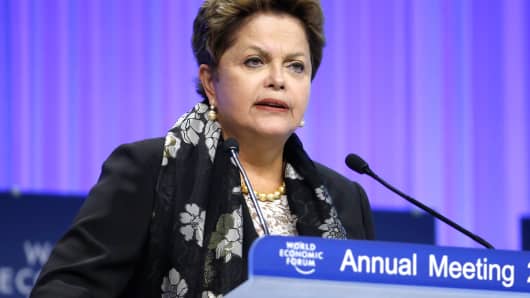In her address, Rousseff, who once battled Brazil's military dictatorship as a Marxist guerrilla, urged investors to look beyond short-term economic performance and to focus on long-term trends.
(Read more: How fragile are emerging markets?)
Brazil will host the World Cup in June, presidential elections in October and the Olympic Games in 2016. Nonetheless, the performance of Brazil's equity market was one of the worse in the emerging world in 2013, while the real became an underperformer.
To recover its BRIC-like growth momentum, Brazil would have to invest much more than the current 19 percent of GDP. After three years of subdued growth, investors are weary of Brazil's short-term prospects. But they should not ignore its medium-term potential.
From Lula's lucky stars to Rousseff's rough ride
Unlike other nations that have gotten stuck in the "middle-income trap," Brazil's first female president wants to see most profits from petroleum exports go to education, thus transforming Brazil's finite resource into lasting human capital. To achieve the transition, however, Rousseff needs growth.
President Lula da Silva took his office amid significant turmoil in Brazil. Yet, his two terms were aligned with lucky stars. As long as China enjoyed its world-historical double-digit growth and international trade soared, Brazil exported commodities that were vital for the mainland's sustained industrialization.
(Read more: Fed volatility is emerging markets 'poison': Analyst)
Through these years, Lula and his then-chief of staff Rousseff sought to ensure that the profits of the catch-up growth did not go to the few and mighty, but to the new middle-classes whose consumption would drive growth in the future.
As Lula was succeeded by President Rousseff, China began its rebalancing and global growth prospects have been diminished, which, in turn, has meant an eclipse of the commodity-driven growth in Brazil.
The good news is that, since 2003, Brazil has brought 42 million people into the middle class and grown per-capita income 78 percent, even while paying down the national debt and keeping inflation under control. Further, the recovery is anticipated to continue in 2014, fueled by a pickup in investment and resilient consumption.
However, as monetary easing is shifting toward a tightening cycle in major advanced economies, Brazil's growth potential has been revised down accordingly.
Toward October elections
In the past few years, Rousseff's popularity has declined to 45 percent from almost 60 percent among the voting public. Nonetheless, she continues to lead the polls for a second term.
Senator Aecio Neves, the most market-friendly candidate, would like to put the Brazilian Social Democracy Party (BSDP) back in power for the first time since 2002. That requires the working-class vote, however. He garnered nearly 20 percent of the vote — before bribery allegations.
(Read more: Will Argentina's woes hit Brazil?)
With their alliance, Socialist leader Eduardo Campos and former senator and Environmental Minister Marina Silva appeal to opposition and independent voters. The duo is regarded as more market-friendly than Rousseff, but less reformist than Neves. Their combined support is less than 20 percent. Further, the duo's slow efforts to come up with a joint platform did not foster an impression of unity.
But it is still a long way to October. Election outcome could be re-shaped by any major disruption — including huge public protests.
From pessimism to post-election hope
Last year, Brazil's growth was 2.5 percent. It may remain barely 2 percent in 2014 but climb to almost 4 percent by 2015. Although the nation's benchmark interest rate is now at 10.5 percent, inflation may amount to 6 percent through the period. As debt increases, credibility will decline.
While tighter monetary policy in the advanced economies has caused short-term volatility for emerging markets, Brazil is not Argentina. It is more favorably positioned, with over $379 billion in foreign reserves and solid medium-term outlook. It is the only BRIC economy, which managed to reduce inequities amid rapid growth.
In part, Brazil's malaise is the result of its past success. New growth must rely more on the pace of capital deepening and productivity growth, which requires successful implementation of infrastructure investment, higher domestic saving and structural reforms to improve competitiveness.
(Read more: Emerging-market turmoil sparks credit-crunch fears)
In the past decade, Brazil has moved decisively from laissez-faire policies toward inclusive growth. Consequently, the real challenge for President Rousseff is to sustain her policies and still retain the administration's credibility in the markets. A credible primary surplus target might be one way to do so.
Ironically, the diminished expectations of the observers, which work against Rousseff in the short term, may support her as reduced uncertainty may fuel more positive investor expectations in 2015.
— By Dan Steinbock
Dan Steinbock is research director of International Business at India China and America Institute (USA), visiting fellow at Shanghai Institutes for International Studies (China) and in the EU-Center (Singapore). See also www.differencegroup.net.


